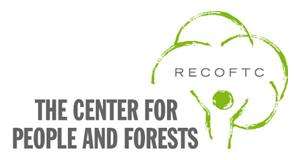RECOFTC – The Center for People and Forests
 | |
| International non-governmental organization | |
| Industry | Capacity building |
| Founded | 1987 |
| Headquarters | Bangkok, Thailand |
| Website | www.recoftc.org |
RECOFTC – The Center for People and Forests is an international not-for-profit organization that focuses on capacity building for community forestry in the Asia Pacific region. It advocates for the increased involvement of local communities living in and around forests - some 450 million people in Asia-Pacific - in the equitable and ecologically sustainable management of forest landscapes. The Regional Community Forestry Training Center for Asia and the Pacific (RECOFTC) opened in Bangkok, Thailand, in March 1987 with support from the United Nations Food and Agriculture Organization, the Government of Switzerland (through the Asian Development Bank), and Thailand's Kasetsart University.
Originally a regional training and research hub for community forestry, RECOFTC now works on the ground through a network of strategic partnerships with governments, NGOs, development organizations and local people throughout Asia-Pacific, and has worked in parts of Africa. In 1999, a charter was developed with a proposal to turn RECOFTC into an international organization, which was signed by seven countries (all the Mekong countries and Switzerland). In 2000, the Royal Thai Government (RTG) signed an agreement with RECOFTC that formally recognized the Center as an autonomous international organization.
Training, capacity building and other learning activities remain central to RECOFTC's work, now complemented with on-the-ground projects, policy work, and strategic communications. In 2009, the organization adopted the new name RECOFTC – The Center for People and Forests to reflect this broader scope of work.
To strengthen its regional program, RECOFTC established country program offices in Cambodia, Indonesia, Thailand, and Vietnam in 2010. These four countries have made a commitment to scale up community forestry, and RECOFTC's enhanced on-the-ground presence is designed to help ensure their commitments develop into tangible results that contribute to national development goals and MDGs.
Mission
RECOFTC's mission is to enhance capacities at all levels to assist the people of the Asia-Pacific region in developing community forestry and managing forest resources for optimum social, economic, and environmental benefits.[1]
The mission is driven by three guiding principles:
- Clear and strong rights are essential if local people, especially the poorest and most vulnerable, are to actively engage in and benefit from forest management. RECOFTC works on strengthening local people's rights to access, use, and own forests through tenure, policy, and market reforms.
- Good governance is necessary for the development and implementation of "community friendly" national forest policies, programs, and regulatory frameworks. RECOFTC promotes the rule of law, transparency, accountability, and the meaningful participation of people in local decision-making processes.
- A fair share of benefits for local people from forestry is needed to help reduce poverty and motivate active participation in forest governance and management. RECOFTC aims to increase and diversify sustainable income generation opportunities from forest management, and to ensure that benefits are shared equitably.
Thematic areas
The Center’s work is focused in four thematic areas:
- Expanding community forestry: Through frontline country programs, RECOFTC works to secure rights for forest-dependent communities to manage their forests. RECOFTC-supported sites — maintained in close partnership with communities, nongovernment organizations (NGOs), and all levels of government — demonstrate good practices and develop key lessons, which are shared nationally and internationally to accelerate the scaling up of community forestry and its impacts.
- People, forests, and climate change: In the Asia-Pacific region, local people hold the key to forests fulfilling their potential for climate change mitigation and adaptation. Community forestry is also an effective means of increasing communities' resilience to the impacts of climate change. RECOFTC advocates for pro-poor climate change strategies and policies, working to ensure that all forestry stakeholders, especially those at the grassroots level, are prepared to meet the social, economic, and financial challenges that lie ahead.
- Transforming forest conflict: Marginalized communities, powerful commercial plantation developers, corruption, unclear land tenure laws — stories of local people involved in conflicts over forest resources regularly fill the pages of the region's newspapers, exposing the scale of damaging impacts. By analyzing and better understanding conflict dynamics, this program promotes lasting solutions at both the policy and community levels.
- Securing local livelihoods: RECOFTC's livelihoods program seeks to realize the full potential of forest-related resources. By analyzing the opportunities and constraints of local people's access to market-based forest activities, this program proposes solutions that are socially just. It helps to ensure that local people have the skills and knowledge to engage meaningfully in emerging opportunities, such as payment for ecosystem services, carbon markets, certification schemes, and non-timber enterprises.
The Center's portfolio currently includes over 40 projects and services, including large capacity-building projects for REDD+ regionally and for community forestry in Cambodia. Initiatives such as the Regional Conflict Study, the Responsible Asia Forestry and Trade (RAFT) program, and REDD-Net allow the Center to share global trends and issues concerning people and forests with national and local stakeholders in local languages. In turn, feedback from them and lessons learned are shared with global audiences at key international fora. The Center continues to engage with policy makers through expert consortia like the Forest Stewardship Council, Asia-Pacific Forestry Commission, International Union of Forest Research Organizations (IUFRO), International Tropical Timber Organization (ITTO), and the ASEAN Social Forestry Network (ASFN).
Capacity building
Since its inception in 1987 as a regional training institution for forestry, the Center has trained over ten thousand practitioners at all levels in community forestry. The Center’s capacity-building program[2] consists of training courses, learning activities and networks, workshops, and study tours. The program seeks to enhance skills in its four thematic areas, listed above.
During the current program cycle beginning in 2008, some 316 capacity-building activities reaching more than 8,500 clients from 26 countries have contributed to RECOFTC's reputation as a leading regional knowledge hub for community forestry.
References
- ↑ http://www.recoftc.org/basic-page/our-vision
- ↑ RECOFTC Training Center: http://www.recoftc.org/site/Training-Center/